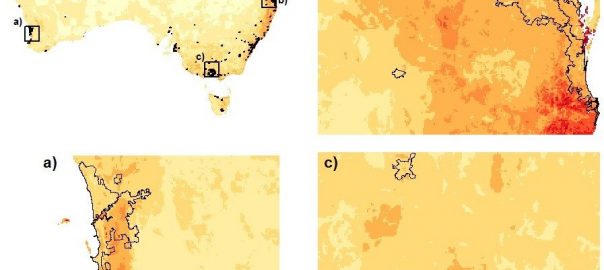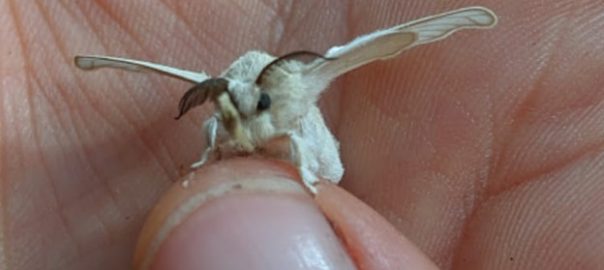My and my colleagues’ recent research from Australia has shown that cities are hotspots for threatened species (Ives et al 2015). There is a remarkable diversity of rare plants and animals that exist alongside the places where people live and work.
While results from this new study are striking, they do not necessarily tell us how we ought to respond. How does the knowledge that cities are important for the protection of threatened species change how we should think about their form and function? Can cities ever practically protect threatened species, or will they always be considered major threats to their survival? And how can we navigate the differences between the perceived conservation importance of these species compared to the often-indifferent perspective of the general public and other stakeholders?
Threatened species are seen as the flagships of the conservation movement. So many NGOs focus their efforts on protecting species (e.g., the WWF), as do many public policy-oriented organizations (e.g., the IUCN). But how should threatened species be considered in the context of cities? City planners often talk about the benefits of green infrastructure for cooling and recreational opportunities, but can cities also contribute to the protection of the most vulnerable forms of biodiversity? There have been a number of studies that have identified threatened animals and plants within cities and towns (Mark Hostetler’s and Aliyu Barau’s recent essays; Schwartz et al.’s 2002 study). In fact, a recent piece of research that my colleagues and I conducted has shown that cities actually are home to more threatened species in a given area on average than non-urban areas.
We took maps of the habitat distributions of the 1643 plants and animals listed as threatened in Australia and overlaid them with maps of the 99 Australian cities and towns with more than 10,000 people (Fig 1). From this spatial analysis, we calculated the number of threatened species in 1km x 1 km squares across the continent and compared urban and non-urban areas.

We found that cities contained substantially more species per square kilometer than non-urban areas (see Fig 2), and this was consistent even when we accounted for bioregion, net primary productivity and distance from the coast. Interestingly, patterns were different for plants and animals. We found that while there tended to be more threatened plants than animals in cities, animals were distributed over more cities than plants. Further, we found that each city in Australia contributed species found nowhere else. Therefore, for conservation, it is important to consider each city and its importance for protecting biodiversity. Why did we find these results? We suggest that the higher richness of threatened species in cities is likely to be the result of both elevated threats from urbanization pressures (e.g. habitat loss, invasive species, disturbance), and novel habitats and resources (e.g. non-native fruiting trees) that benefit some of the species (for example exotic pine plantations offering foraging habitat for Carnaby’s Black Cockatoo).

So what should we do about it? That’s the question that is usually asked by scientists after uncovering an interesting research finding. But actually, that’s one question ahead of where we should start. The first question should be: Why should we do something about it? This relates to the underlying ethical questions of why we ought to pursue conservation.
The ancient Greeks thought about three types of knowledge: episteme, techne, and phronesis. Episteme refers to scientific (or theoretical) knowledge; techne refers to knowledge of practice (how to act), and phronesis to wisdom. In modern western society, scientific knowledge is often considered the most important type of knowledge in decision-making because of the assumption that it will lead to improved outcomes. But we spend very little time discussing what kinds of outcomes are important and what is the right way to pursue them. Yet this kind of wisdom is at the crux of designing sustainable cities. While we have much scientific knowledge, very often there is little shared understanding of value between stakeholders. Not everyone recognises the value of protecting biodiversity, with many viewing environmental features as constraints to more important outcomes, such as residential housing and opportunities for industry.
This connects to a debate that’s been raging on the pages of conservation journals for a while now. Why should we protect nature? Two recent additions to this dialogue have been made by Kai Chan and colleagues and Richard Pearson. Chan et al. argue that the two classes of values that are typically used to justify nature protection (namely nature for human’s sake [instrumental value] or for nature’s sake [intrinsic value]) are insufficient. They recognise that a third type of values is critical and actually very often represent the most significant values of all: relational values. People do not only value nature because it is there or because it fulfils their preferences; they also engage with it in a variety of other ways, stewarding and respecting it, observing it, interacting with it. These kinds of nuanced relationships with the natural world are not captured by the category of ‘cultural ecosystem services’, since this continues to frame nature in terms of what it can offer people.
The article by Pearson, published in 2016, recognises that “different arguments for conservation are suited to different spatial extents and levels of biological organization” (p2). In other words, not only are there different kinds of values for nature, but different attributes of nature motivate conservation action in different ways. He distinguishes between genes, populations, species, and ecosystems. Each of these is more closely aligned with different motivations for conservation (e.g. populations of insects for pollination, or ecosystem health for recreation) (see Fig 3). They are also relevant at different spatial scales. For example, climate regulation is a global motivation for maintaining ecosystem function, while maintaining clean water for swimming is a local motivation. Regarding threatened species, Pearson suggests that the existence value (or intrinsic value) of that species is of global concern.
Conservation of threatened species in cities therefore represents a clash between the local and global scales of motivations, since the local economic value of transforming habitat for residential housing is compared with the global motivation of maintaining species existence. This mismatch of scales (and the different kinds of values at play) makes it difficult to perform sensible tradeoffs. And when it comes down to it, species protection often loses out. In response, compensation schemes (such as biodiversity offsetting) have been introduced as a way of upholding legal requirements for species protection, but these are ethically problematic for a range of reasons—not least because they fail to consider adequately the complexity of value relationships between people and nature (Ives & Bekessy, 2015).

So what does all this mean for the conservation of threatened species in cities? Given that cities are defined by a dominance of human-modified landscapes and act as engine rooms of economic development, it is critical that the public are engaged closely in this issue. People must be made aware that cities are actually hotspots for threatened species. There is a need to make the global importance of species protection relevant at a local level. This can be achieved through careful education by government and community conservation groups, particularly concerning species that reside in people’s local areas. Without public support, species will continue to be pushed to the brink of extinction, despite legal protection—as exemplified by the recent case in Melbourne, where habitat corridors have been downgraded in new planning documents (ABC, 2015)
Second, there is a need for the range of values people assign to natural areas to be expressed and picked up by land use planners and managers. Alongside the ‘intrinsic’ value of threatened species, values such as the aesthetic, cultural, recreational, bequest and scientific values of their habitats should be understood and articulated in order to bolster arguments for conservation in cities. Finally, urban dwellers should be actively engaged in conservation actions where possible as a way of building positive nature experiences and engendering an ethic of nature stewardship. Conservation action on private land, not just the formal areas designated for nature protection, is likely to be an important part of this.
Now for one final thought. In the end, all of this talk about managing different values is prefaced on the assumption that we are permitted to act in whichever way we like towards the environment as long as our particular values for it are upheld. Yet, I think much of the talk about intrinsic value is actually trying to express some kind of moral obligation we have towards the natural world.
But I think that talking about values may not be enough. We need to start discussing ethics, and what principles govern our actions as people. Instead of asking ‘what values should we be accounting for in justifying our actions towards the environment’, we could be asking ‘what kind of actions are consistent with a respectful relationship towards nature?’. This doesn’t fit neatly into our cost-benefit analysis world, but I think it is an important step towards realising a sustainable and just future in the age of urbanisation. We therefore need to explore more about the ethical principles that ought to govern cities.
I suggest that we certainly should be maintaining relationships with nature through planning and designing urban landscapes that facilitate meaningful human-nature interactions. An ethical city should recognise the values for nature protection at different scales and show leadership in how people can learn to live sustainably alongside nature. As a first step, let’s work hard to protect the most vulnerable species that are present in our cities—those on the brink of extinction.
Chris Ives
Lüneburg












Hi Mark, you’re right – proximity to water is likely to be a major factor driving biodiversity patterns. What was interesting is that our findings showed cities were more important for threatened species even after taking into account the distance of the city from the coast and the overall Net Primary Productivity of the region. I agree, it’s so important to engage local residents. I think this is the big next step in urban conservation!
An interesting blog and an interesting result. I’m sure you did so, but how did you compensate for the inherent biasing factor that cities may PRODUCE threatened species? I.e. a species with limited spatial or ecotype distribution previously existed stably outside a city; the city grows and the suburbs now reduce the habitat for that species?
Clement Kent
Chris – interesting that more threatened species were found in urban areas. Did this also hold true despite that most cities (I assume) are next to water bodies and waterways? Regardless, engaging the local populace is a challenge as we have found that providing green infrastructure is only the first step. Nearby resident activities can cause these remnant (threatened) species to blink out over time.